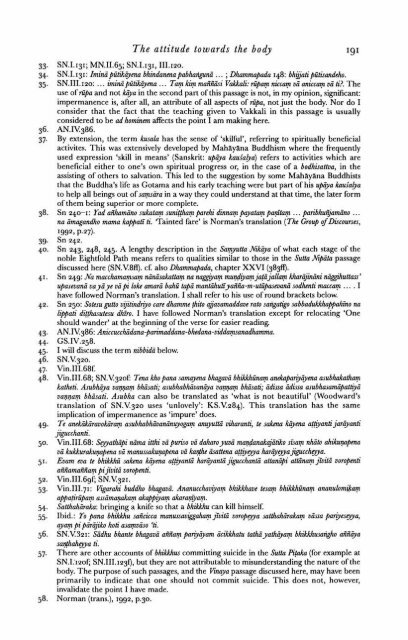Identity and Experience_Hamilton_1996
Identity and Experience_Hamilton_1996
Identity and Experience_Hamilton_1996
You also want an ePaper? Increase the reach of your titles
YUMPU automatically turns print PDFs into web optimized ePapers that Google loves.
The attitude towards the body<br />
SN.1.131; MN.II.65; SN.1.131, 111.120.<br />
SN.1.131: IminiipitikQena bhindanenapabhatigunii . .. ; Dhammapada 148: bh&atipih<strong>and</strong>eh.<br />
SN.III.120: . . . imincipftika>ena . . . Tam kim man"n"(7ri Vhkkali: nipam nucam vii aniccap vii ti?. The<br />
use of nipa <strong>and</strong> not kqa in the second part of this passage is not, in my opinion, significant:<br />
impermanence is, after all, an attribute of all aspects of nipa, not just the body. Nor do I<br />
consider that the fact that the teaching given to Vakkali in this passage is usually<br />
considered to be ad hominem affects the point I am making here.<br />
AN.IV.386.<br />
By extension, the term kusala has the sense of 'skilful', referring to spiritually beneficial<br />
activites. This was extensively developed by Mahayana Buddhism where the frequently<br />
used expression 'skill in means' (Sanskrit: upqa kauiaha) refers to activities which are<br />
beneficial either to one's own spiritual progress or, in the case of a bodhisattva, in the<br />
assisting of others to salvation. This led to the suggestion by some Mahayana Buddhists<br />
that the Buddha's life as Gotama <strong>and</strong> his early teaching were but part of his upliya kadalya<br />
to help all beings out of sapsira in a way they could underst<strong>and</strong> at that time, the later form<br />
of them being superior or more complete.<br />
Sn 240-1: Yad admmcino sukatam sunittham parehi dinnam payatam pa@tam . . . paribhufijamiino . . .<br />
nu iimag<strong>and</strong>ho mama ka@ati ti. Tainted fare' is Norman's translation (Th Group ofDircourses,<br />
'992, p.27).<br />
Sn 242.<br />
Sn 243, 248, 245. A lengthy description in the Samyutta Aiikqa of what each stage of the<br />
noble Eightfold Path means refers to qualities similar to those in the Sutta Mpita passage<br />
discussed here (SN.V.8fl). cf also Dhammafiada, chapter XXVI (383fl).<br />
Sn 249: Na macchamapsam nZn&akattam na -yam rnudeam ja@jab kharcsjkini tllig-gthuttm'<br />
uparevanii vayiiye vii pi lob amari bahi tap5 mankihutiyaiiiia-m-uhi~arevanii sodhenti maccam ... . I<br />
have followed Norman's translation. I shall refer to his use of round brackets below.<br />
Sn 250: Sottsu gutto vijitindriyo care dhamme fiito ajavamaddave rato satigatgo sabbadukkhaflahino nu<br />
lij$ati dittharutesu dhiro. I have followed Norman's translation except for relocating 'One<br />
should w<strong>and</strong>er' at the beginning of the verse for easier reading.<br />
AN.IV.386: Anitnrcchiidana-panmaddana-bhedana-v-mma.<br />
GS.IV.258.<br />
I will discuss the term nibbidE below.<br />
SN.V.320.<br />
Vin.III.68f:<br />
Vin.III.68; SN.V.32of: Tm kho panu samayena bhagavii bhikkhham a&panyCrym arubhakatJzam<br />
kahti. Asubhl?ya vagam bhisati; asubhabhiivan*a vacm bhcisati; adirra iidirra asubhmamtSpatCiyii<br />
vapnam bhisati. Asubha can also be translated as 'what is not beautiful' (Woodward's<br />
translation of SN.V.32o uses 'unlovely': KS.V.284). This translation has the same<br />
implication of impermanence as 'impure' does.<br />
Te anekc7kiiravokiiram ancbhabhiivaniinuyogam anuyutki viharanti, te sakena kgena attiyanti jarciyanti<br />
j&ucchanti.<br />
Vin.III.68: Sgyathiipi niima itthi vi puriro vii daharoyuvii madanakajitiko siiam nhrito ahikupzpena<br />
vii kukkurakupzpena vii manussakupzfiena vii ka@e Zsattena a#jeyya har@eyya jigucchgya.<br />
Evam eva te bhikkhg sakena kqena a@yantii harc?yantij@cchantii attaniipi atkinam jivitci voropenti<br />
aiifiamairiram pijivitii voropenti.<br />
Vin.III.6gc sN.V321.<br />
Vin.111.71: Ygarahi buddho bhagavii. Ananucchauiyam bhikkhave tesam bhikkhQ~ ananulomi(cam<br />
uppatinipam asrcimayakam akapfiyam akara@yam.<br />
Satthahiiraka: bringing a knife so that a bhiWchu can kill himself.<br />
Ibid.: Yo pana bhikkhu saircicca manussav&jaham jivitii vorofigrya satthahiirakam vka panyeseyya,<br />
ayam pi pir@iko hoti aamviiSO 'ti.<br />
sN.V.321: Siidhu bhnte bhagavi an"tZam pany(7vam Watu tathiiyathl7yam bhikkhuratigho aAR(7ra<br />
sa~ahgya ti.<br />
There are other accounts of bhikWlus committing suicide in the Sutta Wka (for example at<br />
SN.I:12ofi SN.III.I~~~), but they are not attributable to misunderst<strong>and</strong>ing the nature of the<br />
body. The purpose of such passages, <strong>and</strong> the Vinaya passage discussed here, may have been<br />
primarily to indicate that one should not commit suicide. This does not, however,<br />
invalidate the point I have made.<br />
Norman (trans.), 1992, p.30.


